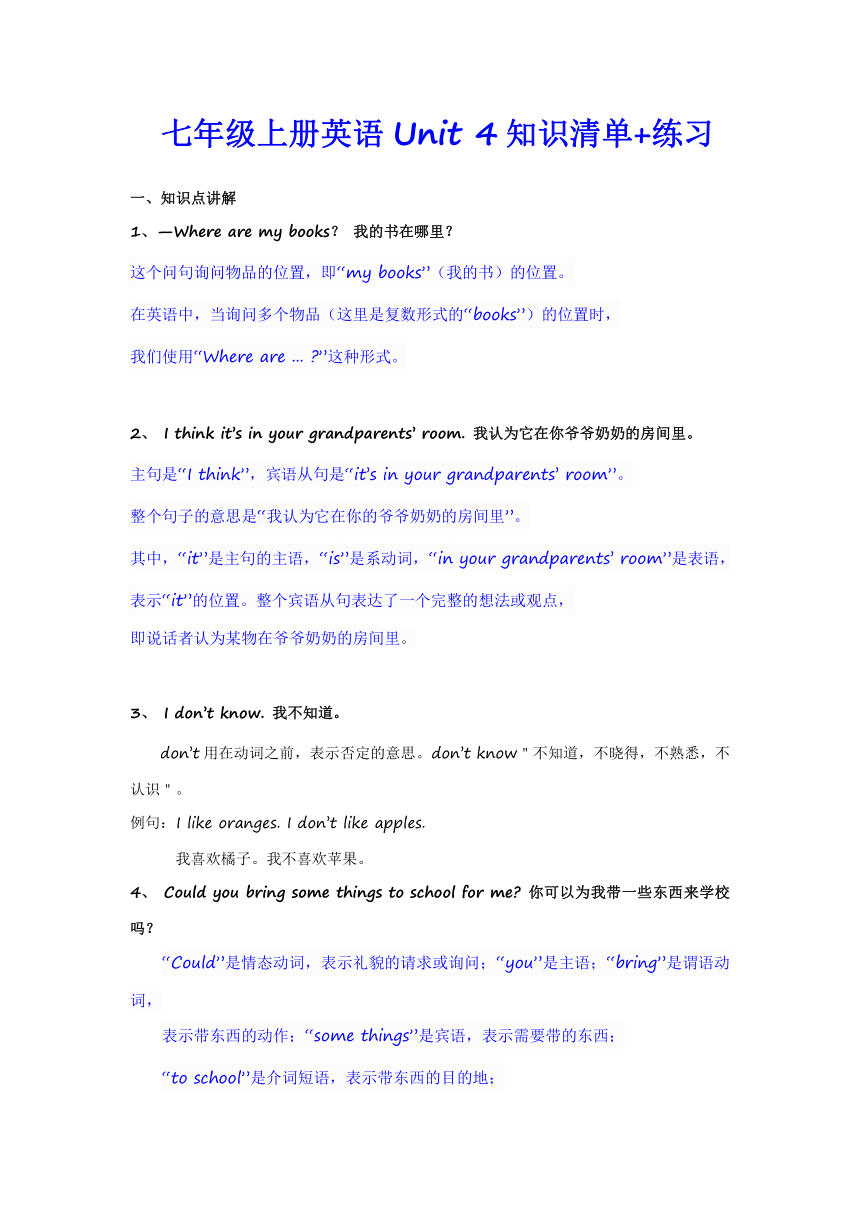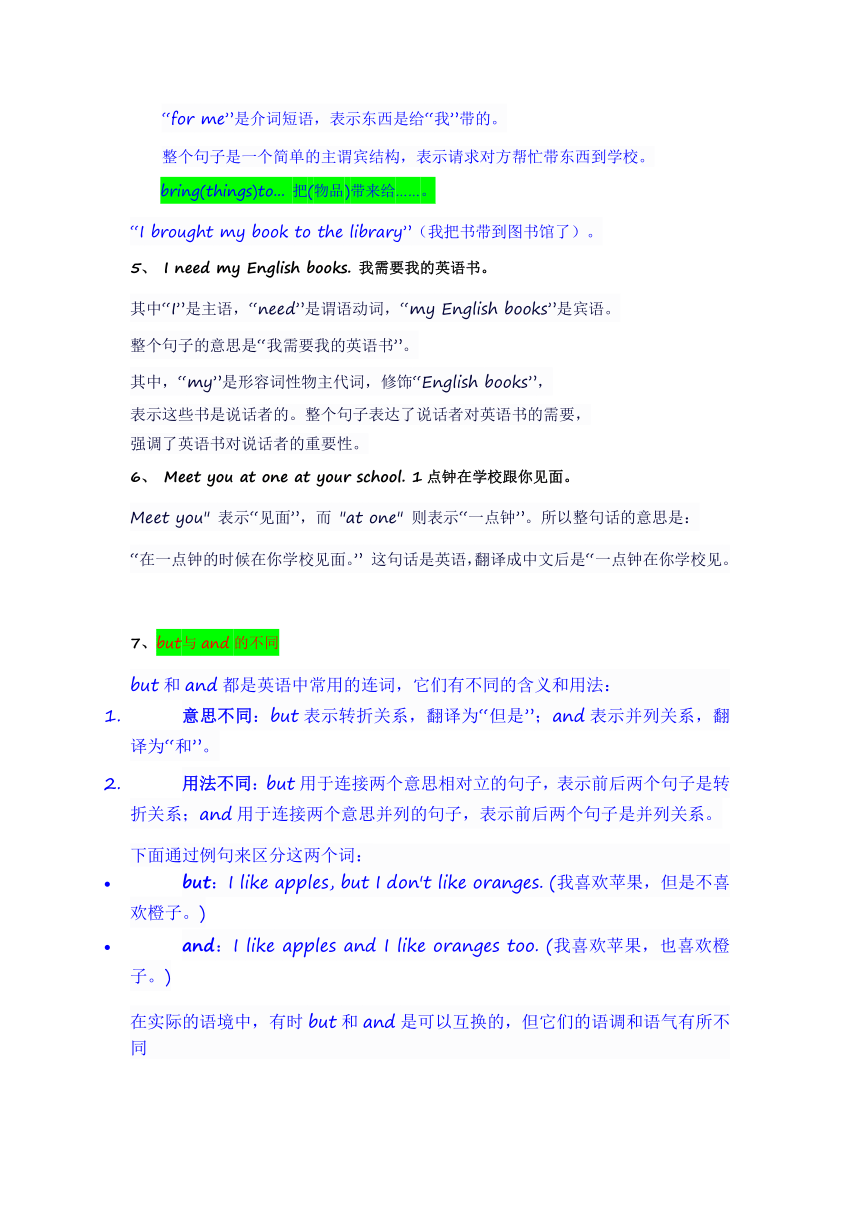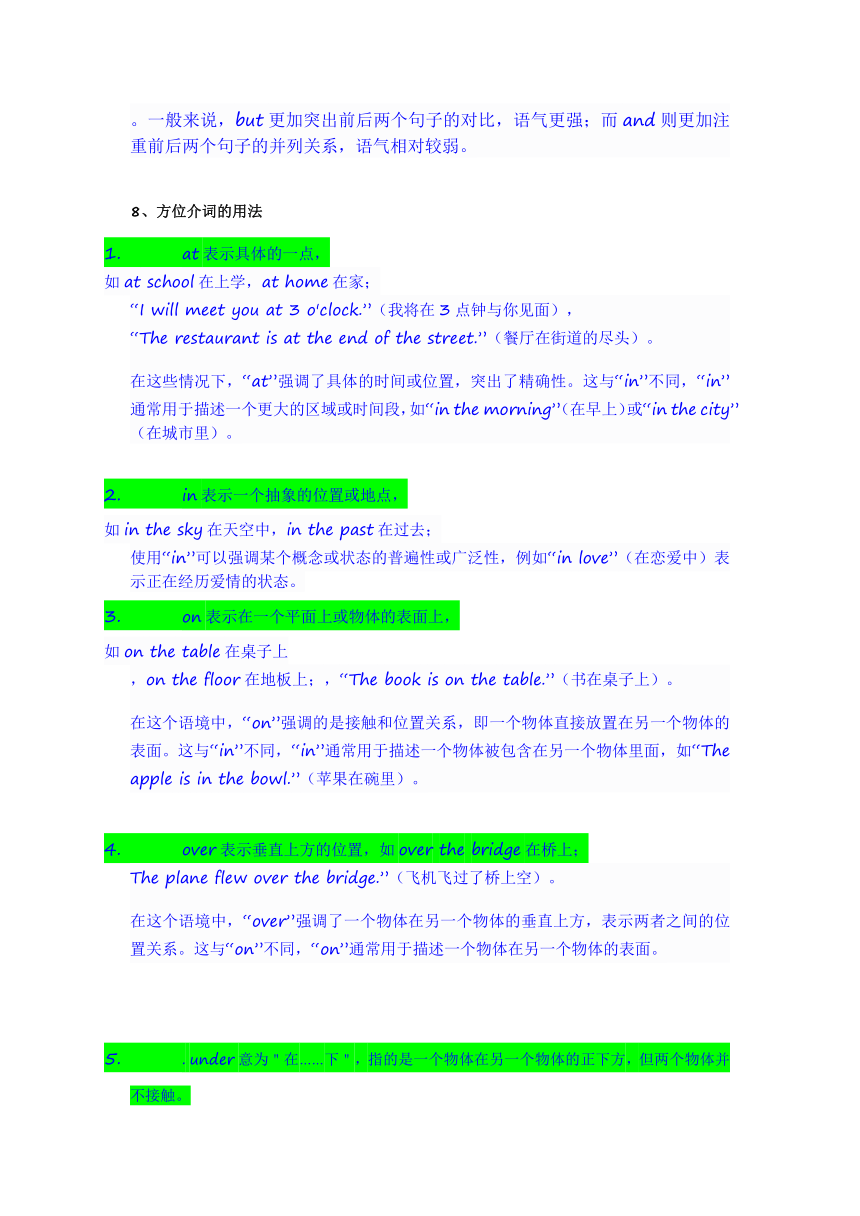人教版七年级上册Unit 4Where's my schoolbag?知识清单练习 (无答案)
文档属性
| 名称 | 人教版七年级上册Unit 4Where's my schoolbag?知识清单练习 (无答案) |  | |
| 格式 | docx | ||
| 文件大小 | 32.5KB | ||
| 资源类型 | 教案 | ||
| 版本资源 | 人教新目标(Go for it)版 | ||
| 科目 | 英语 | ||
| 更新时间 | 2024-01-08 08:45:44 | ||
图片预览



文档简介
七年级上册英语Unit 4知识清单+练习
一、知识点讲解
1、—Where are my books? 我的书在哪里?
这个问句询问物品的位置,即“my books”(我的书)的位置。
在英语中,当询问多个物品(这里是复数形式的“books”)的位置时,
我们使用“Where are ... ”这种形式。
I think it’s in your grandparents’ room. 我认为它在你爷爷奶奶的房间里。
主句是“I think”,宾语从句是“it’s in your grandparents’ room”。
整个句子的意思是“我认为它在你的爷爷奶奶的房间里”。
其中,“it”是主句的主语,“is”是系动词,“in your grandparents’ room”是表语,
表示“it”的位置。整个宾语从句表达了一个完整的想法或观点,
即说话者认为某物在爷爷奶奶的房间里。
I don’t know. 我不知道。
don’t用在动词之前,表示否定的意思。don’t know"不知道,不晓得,不熟悉,不认识"。
例句:I like oranges. I don’t like apples.
我喜欢橘子。我不喜欢苹果。
Could you bring some things to school for me 你可以为我带一些东西来学校吗?
“Could”是情态动词,表示礼貌的请求或询问;“you”是主语;“bring”是谓语动词,
表示带东西的动作;“some things”是宾语,表示需要带的东西;
“to school”是介词短语,表示带东西的目的地;
“for me”是介词短语,表示东西是给“我”带的。
整个句子是一个简单的主谓宾结构,表示请求对方帮忙带东西到学校。
bring(things)to... 把(物品)带来给……。
“I brought my book to the library”(我把书带到图书馆了)。
I need my English books. 我需要我的英语书。
其中“I”是主语,“need”是谓语动词,“my English books”是宾语。
整个句子的意思是“我需要我的英语书”。
其中,“my”是形容词性物主代词,修饰“English books”,
表示这些书是说话者的。整个句子表达了说话者对英语书的需要,
强调了英语书对说话者的重要性。
Meet you at one at your school. 1点钟在学校跟你见面。
Meet you" 表示“见面”,而 "at one" 则表示“一点钟”。所以整句话的意思是:
“在一点钟的时候在你学校见面。” 这句话是英语,翻译成中文后是“一点钟在你学校见。
7、but与and的不同
but和and都是英语中常用的连词,它们有不同的含义和用法:
意思不同:but表示转折关系,翻译为“但是”;and表示并列关系,翻译为“和”。
用法不同:but用于连接两个意思相对立的句子,表示前后两个句子是转折关系;and用于连接两个意思并列的句子,表示前后两个句子是并列关系。
下面通过例句来区分这两个词:
but:I like apples, but I don't like oranges. (我喜欢苹果,但是不喜欢橙子。)
and:I like apples and I like oranges too. (我喜欢苹果,也喜欢橙子。)
在实际的语境中,有时but和and是可以互换的,但它们的语调和语气有所不同
。一般来说,but更加突出前后两个句子的对比,语气更强;而and则更加注重前后两个句子的并列关系,语气相对较弱。
8、方位介词的用法
at表示具体的一点,
如at school在上学,at home在家;
“I will meet you at 3 o'clock.”(我将在3点钟与你见面),
“The restaurant is at the end of the street.”(餐厅在街道的尽头)。
在这些情况下,“at”强调了具体的时间或位置,突出了精确性。这与“in”不同,“in”通常用于描述一个更大的区域或时间段,如“in the morning”(在早上)或“in the city”(在城市里)。
in表示一个抽象的位置或地点,
如in the sky在天空中,in the past在过去;
使用“in”可以强调某个概念或状态的普遍性或广泛性,例如“in love”(在恋爱中)表示正在经历爱情的状态。
on表示在一个平面上或物体的表面上,
如on the table在桌子上
,on the floor在地板上;,“The book is on the table.”(书在桌子上)。
在这个语境中,“on”强调的是接触和位置关系,即一个物体直接放置在另一个物体的表面。这与“in”不同,“in”通常用于描述一个物体被包含在另一个物体里面,如“The apple is in the bowl.”(苹果在碗里)。
over表示垂直上方的位置,如over the bridge在桥上;
The plane flew over the bridge.”(飞机飞过了桥上空)。
在这个语境中,“over”强调了一个物体在另一个物体的垂直上方,表示两者之间的位置关系。这与“on”不同,“on”通常用于描述一个物体在另一个物体的表面。
. under意为"在……下",指的是一个物体在另一个物体的正下方,但两个物体并不接触。
The book is under the table”,这意味着书在桌子正下方,但不一定贴着桌子。这与“on”不同,“on”强调直接接触。
练一练
The school is _______ the post office.
A. on the opposite side of B. in front of C. behind D. next to
---Where is the nearest post office
---It's _______ the bookstore _______ the right.
A. in front of; on B. in front of; on C. in front of; at D. in front; on
---Where is the nearest post office
---It's across from the bank _______ the right.
A. on B. in C. at D. by
---Where is the nearest post office
---It's next to the library _______ the left side of the street.
A. on B. in C. at D. by
---Where is the nearest post office
---It's _______ the bookstore _______ the right side of the street.
A. in front of; at B. in front of; on C. opposite to; on D. opposite to; at
9、where引导的特殊疑问句
(1)用法:where是疑问副词,意为"在哪里;到哪里",用来引导特殊疑问句。
常用句型"Where is+单数名词 "
"Where are+复数名词 "询问人或物所在的位置。
询问某个单数或复数名词所在的位置。例如,“Where is the book ”
“Where are the books ”可以用来询问一本书或一些书的位置。
回答
A:用It’s…(对应Where is… )或They’re…(对应Where are… )作答。
Where is the train station It’s over there.
Where are the keys They’re on the table.
Where is the nearest gas station It’s just around the corner.
B:直接说出物品所在地点,省略it’s或they’re。
"The book is on the table."(书在桌子上),而不是说"It's on the table."。
对于多个物品,你也可以省略"they're",直接描述每个物品的位置,
例如"A pencil is on the desk. A pen is in the drawer."(一支铅笔在书桌上,一支钢笔在抽屉里)
课后作业
(一)单项选择
1.—This ruler is Bob’s. ________
—It’s Tom’s.
A.What about this ruler B.What color is the ruler
C.What’s this in English D.Where is the ruler
2.I have two friends, Lily ________ Lucy. ________ I don’t know their telephone numbers.
A.and; and B.and; but C.but; and D.but; but
3.— ________ is my pen
—It’s on the desk.
A.What B.Where C.Who D.How
4.The police put a photo of the criminal ________ newspapers and ________ television to find him.
A.in; on B.on; on C.on; to D.in; to
5.Fujian is ________ the south of China and ________ the north of Taiwan.
A.to; in B.on; to C.in; to D.in; /
二、用所给单词的正确形式填空
1.Those schoolbags (be) on the table now.
2.There (be) some drinks in the shopping basket.
3.Most of the news (be) not good.
4.The eraser isn’t (my).
5.How are (you)
一、知识点讲解
1、—Where are my books? 我的书在哪里?
这个问句询问物品的位置,即“my books”(我的书)的位置。
在英语中,当询问多个物品(这里是复数形式的“books”)的位置时,
我们使用“Where are ... ”这种形式。
I think it’s in your grandparents’ room. 我认为它在你爷爷奶奶的房间里。
主句是“I think”,宾语从句是“it’s in your grandparents’ room”。
整个句子的意思是“我认为它在你的爷爷奶奶的房间里”。
其中,“it”是主句的主语,“is”是系动词,“in your grandparents’ room”是表语,
表示“it”的位置。整个宾语从句表达了一个完整的想法或观点,
即说话者认为某物在爷爷奶奶的房间里。
I don’t know. 我不知道。
don’t用在动词之前,表示否定的意思。don’t know"不知道,不晓得,不熟悉,不认识"。
例句:I like oranges. I don’t like apples.
我喜欢橘子。我不喜欢苹果。
Could you bring some things to school for me 你可以为我带一些东西来学校吗?
“Could”是情态动词,表示礼貌的请求或询问;“you”是主语;“bring”是谓语动词,
表示带东西的动作;“some things”是宾语,表示需要带的东西;
“to school”是介词短语,表示带东西的目的地;
“for me”是介词短语,表示东西是给“我”带的。
整个句子是一个简单的主谓宾结构,表示请求对方帮忙带东西到学校。
bring(things)to... 把(物品)带来给……。
“I brought my book to the library”(我把书带到图书馆了)。
I need my English books. 我需要我的英语书。
其中“I”是主语,“need”是谓语动词,“my English books”是宾语。
整个句子的意思是“我需要我的英语书”。
其中,“my”是形容词性物主代词,修饰“English books”,
表示这些书是说话者的。整个句子表达了说话者对英语书的需要,
强调了英语书对说话者的重要性。
Meet you at one at your school. 1点钟在学校跟你见面。
Meet you" 表示“见面”,而 "at one" 则表示“一点钟”。所以整句话的意思是:
“在一点钟的时候在你学校见面。” 这句话是英语,翻译成中文后是“一点钟在你学校见。
7、but与and的不同
but和and都是英语中常用的连词,它们有不同的含义和用法:
意思不同:but表示转折关系,翻译为“但是”;and表示并列关系,翻译为“和”。
用法不同:but用于连接两个意思相对立的句子,表示前后两个句子是转折关系;and用于连接两个意思并列的句子,表示前后两个句子是并列关系。
下面通过例句来区分这两个词:
but:I like apples, but I don't like oranges. (我喜欢苹果,但是不喜欢橙子。)
and:I like apples and I like oranges too. (我喜欢苹果,也喜欢橙子。)
在实际的语境中,有时but和and是可以互换的,但它们的语调和语气有所不同
。一般来说,but更加突出前后两个句子的对比,语气更强;而and则更加注重前后两个句子的并列关系,语气相对较弱。
8、方位介词的用法
at表示具体的一点,
如at school在上学,at home在家;
“I will meet you at 3 o'clock.”(我将在3点钟与你见面),
“The restaurant is at the end of the street.”(餐厅在街道的尽头)。
在这些情况下,“at”强调了具体的时间或位置,突出了精确性。这与“in”不同,“in”通常用于描述一个更大的区域或时间段,如“in the morning”(在早上)或“in the city”(在城市里)。
in表示一个抽象的位置或地点,
如in the sky在天空中,in the past在过去;
使用“in”可以强调某个概念或状态的普遍性或广泛性,例如“in love”(在恋爱中)表示正在经历爱情的状态。
on表示在一个平面上或物体的表面上,
如on the table在桌子上
,on the floor在地板上;,“The book is on the table.”(书在桌子上)。
在这个语境中,“on”强调的是接触和位置关系,即一个物体直接放置在另一个物体的表面。这与“in”不同,“in”通常用于描述一个物体被包含在另一个物体里面,如“The apple is in the bowl.”(苹果在碗里)。
over表示垂直上方的位置,如over the bridge在桥上;
The plane flew over the bridge.”(飞机飞过了桥上空)。
在这个语境中,“over”强调了一个物体在另一个物体的垂直上方,表示两者之间的位置关系。这与“on”不同,“on”通常用于描述一个物体在另一个物体的表面。
. under意为"在……下",指的是一个物体在另一个物体的正下方,但两个物体并不接触。
The book is under the table”,这意味着书在桌子正下方,但不一定贴着桌子。这与“on”不同,“on”强调直接接触。
练一练
The school is _______ the post office.
A. on the opposite side of B. in front of C. behind D. next to
---Where is the nearest post office
---It's _______ the bookstore _______ the right.
A. in front of; on B. in front of; on C. in front of; at D. in front; on
---Where is the nearest post office
---It's across from the bank _______ the right.
A. on B. in C. at D. by
---Where is the nearest post office
---It's next to the library _______ the left side of the street.
A. on B. in C. at D. by
---Where is the nearest post office
---It's _______ the bookstore _______ the right side of the street.
A. in front of; at B. in front of; on C. opposite to; on D. opposite to; at
9、where引导的特殊疑问句
(1)用法:where是疑问副词,意为"在哪里;到哪里",用来引导特殊疑问句。
常用句型"Where is+单数名词 "
"Where are+复数名词 "询问人或物所在的位置。
询问某个单数或复数名词所在的位置。例如,“Where is the book ”
“Where are the books ”可以用来询问一本书或一些书的位置。
回答
A:用It’s…(对应Where is… )或They’re…(对应Where are… )作答。
Where is the train station It’s over there.
Where are the keys They’re on the table.
Where is the nearest gas station It’s just around the corner.
B:直接说出物品所在地点,省略it’s或they’re。
"The book is on the table."(书在桌子上),而不是说"It's on the table."。
对于多个物品,你也可以省略"they're",直接描述每个物品的位置,
例如"A pencil is on the desk. A pen is in the drawer."(一支铅笔在书桌上,一支钢笔在抽屉里)
课后作业
(一)单项选择
1.—This ruler is Bob’s. ________
—It’s Tom’s.
A.What about this ruler B.What color is the ruler
C.What’s this in English D.Where is the ruler
2.I have two friends, Lily ________ Lucy. ________ I don’t know their telephone numbers.
A.and; and B.and; but C.but; and D.but; but
3.— ________ is my pen
—It’s on the desk.
A.What B.Where C.Who D.How
4.The police put a photo of the criminal ________ newspapers and ________ television to find him.
A.in; on B.on; on C.on; to D.in; to
5.Fujian is ________ the south of China and ________ the north of Taiwan.
A.to; in B.on; to C.in; to D.in; /
二、用所给单词的正确形式填空
1.Those schoolbags (be) on the table now.
2.There (be) some drinks in the shopping basket.
3.Most of the news (be) not good.
4.The eraser isn’t (my).
5.How are (you)
同课章节目录
- starters 预备篇(2012秋审查)
- Unit 1 Good morning !
- Unit 2 What’s this in English?
- Unit 3 What color is it ?
- Unit 1 My name's Gina.
- Section A
- Section B
- Unit 2 This is my sister.
- Section A
- Section B
- Unit 3 Is this your pencil?
- Section A
- Section B
- Unit 4 Where's my schoolbag?
- Section A
- Section B
- Unit 5 Do you have a soccer ball?
- Section A
- Section B
- Unit 6 Do you like bananas?
- Section A
- Section B
- Unit 7 How much are these socks?
- Section A
- Section B
- Unit 8 When is your birthday?
- Section A
- Section B
- Unit 9 My favorite subject is science.
- Section A
- Section B
